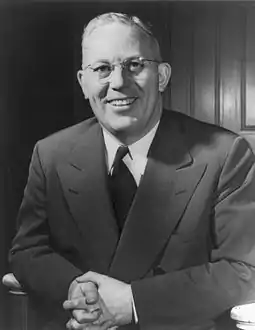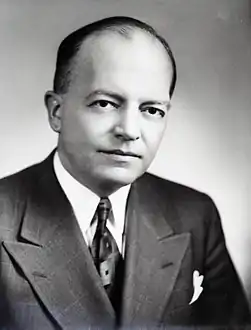1952 Republican Party presidential primaries
The 1952 Republican presidential primaries were the selection process for delegates to the 1952 Republican National Convention.
| |||||||||||||||||||||||||||||||||||||||||
| |||||||||||||||||||||||||||||||||||||||||
 Results map by state. | |||||||||||||||||||||||||||||||||||||||||
| |||||||||||||||||||||||||||||||||||||||||
The fight for the 1952 Republican nomination was largely between Eisenhower, who became the candidate of the party's liberal eastern establishment, and Senator Robert A. Taft of Ohio, the longtime leader of the GOP's conservative wing. The moderate Eastern Republicans were led by New York Governor Thomas E. Dewey, the party's nominee in 1944 and 1948. The moderates tended to be interventionists who felt that America needed to fight the Cold War overseas and resist Soviet aggression in Europe and Asia; they were also willing to accept most aspects of the social welfare state created by the New Deal in the 1930s. The moderates were also concerned with ending the GOP's losing streak in presidential elections; they felt that the personally popular Eisenhower had the best chance of beating the Democrats. The conservative Republicans led by Senator Taft were based in the Midwest and parts of the South. The conservatives wanted to abolish many of the New Deal welfare programs; in foreign policy they were often non-interventionists, who believed that America should avoid alliances with foreign powers. Senator Taft had been a candidate for the GOP nomination in 1940 and 1948, but had been defeated both times by moderate Republicans from New York. Taft, who was 62 when the campaign began, freely admitted that 1952 was his last chance to win the nomination, and this led his supporters to work hard for him. Taft's weakness, which he was never able to overcome, was the fear of many party bosses that he was too conservative and controversial to win a presidential election.
Notable was the absence of Dewey. He strongly supported Eisenhower[1] and played an important role in persuading him to run and helping him win the nomination. Dewey used his powerful political machine to win "Ike" the support of delegates in New York and elsewhere.
Two other major candidates, but not so strong as Eisenhower or Taft, for nomination were Governor of California and Dewey's 1948 running-mate Earl Warren and former Governor of Minnesota Harold Stassen.
Candidates
The following leaders were candidates for the 1952 Republican presidential nomination:
Major candidates
These candidates participated in multiple state primaries or were included in multiple major national polls.
Competing in primaries
| Candidate | Most recent position | Home state | Campaign | ||
|---|---|---|---|---|---|
| Dwight D. Eisenhower |  |
Supreme Allied Commander (1951–52) |
Kansas |
(Campaign) | |
| Robert A. Taft | 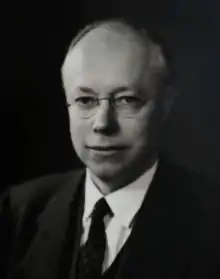 |
U.S. Senator from Ohio (1939–53) |
 Ohio |
(Campaign) | |
| Earl Warren | .jpg.webp) |
Governor of California (1943–53) |
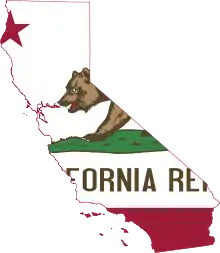 California |
(Campaign) | |
| Harold Stassen | 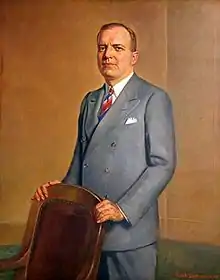 |
Governor of Minnesota (1939–43) |
 Minnesota |
(Campaign) | |
Bypassing primaries
The following candidates did not place their name directly on the ballot for any state's presidential primary, but may have sought to influence selection of un-elected delegates or support of uncommitted delegates.
| Candidate | Most recent position | Home state | Campaign | |
|---|---|---|---|---|
| Douglas MacArthur | 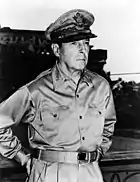 |
General of the Army (1944–51) |
 New York |
|
Favorite sons
The following candidates ran only in their home state's primary or caucus for the purpose of controlling its delegate slate at the convention and did not appear to be considered national candidates by the media.
- Businessman Riley A. Bender of Illinois
- Governor George Theodore Mickelson of South Dakota (Eisenhower surrogate)
- Senator Wayne Morse of Oregon
- Representative Thomas H. Werdel of California (Taft surrogate)
Declined to run
The following persons were listed in two or more major national polls or were the subject of media speculation surrounding their potential candidacy, but declined to actively seek the nomination.
- Senator John W. Bricker of Ohio (ran for re-election)
- Governor Thomas E. Dewey of New York (endorsed Eisenhower)
- Governor Alfred E. Driscoll of New Jersey (endorsed Eisenhower)[2]
- Senator James H. Duff of Pennsylvania (endorsed Eisenhower)
- Senator Henry Cabot Lodge Jr. of Massachusetts (endorsed Eisenhower)
- House Minority Leader Joseph W. Martin Jr. of Massachusetts
- Senator Kenneth S. Wherry of Nebraska
Polling
National polling
| Poll source | Publication | ||||||||
|---|---|---|---|---|---|---|---|---|---|
| Gallup[3][lower-alpha 1] | July 17, 1949 | 20% | 21% | 13% | 21% | 12% | 9% | 16%[lower-alpha 2] | 5% |
| Gallup[4] | Nov. 6, 1949 | 12% | 25% | – | 19% | 15% | 10% | 13%[lower-alpha 3] | 6% |
| Gallup[5] | Apr. 5, 1950 | 15% | 37% | – | 12% | 17% | 5% | 9%[lower-alpha 4] | 8% |
| Gallup[6] | Sep. 26, 1950 | 14% | 42% | – | 14% | 15% | 6% | 3%[lower-alpha 5] | 6% |
| Gallup[7] | Dec. 16, 1950 | 16% | 35% | – | 8% | 24% | 10% | 2% | 5% |
| Gallup[8] | Apr. 13, 1951 | 14% | 38% | – | 9% | 22% | 10% | 3%[lower-alpha 6] | 4% |
| Gallup | May 1951 | 30% | – | 10% | 22% | 13% | |||
| Gallup[9] | Dec. 23, 1951 | 9% | 30% | 14% | 3% | 28% | 11% | 3% | 2% |
| 9% | – | 21% | 6% | 34% | 19% | 7% | 4% | ||
| 11% | 35% | – | 3% | 32% | 13% | 4% | 2% | ||
| Gallup[10] | Feb. 12, 1952 | 5% | 33% | 14% | 5% | 33% | 8% | – | 2% |
| Gallup[11] | Mar. 2, 1952 | 5% | 33% | 14% | 6% | 34% | 6% | – | 2% |
| Gallup[12] | Apr. 8, 1952 | 3% | 37% | 12% | 4% | 34% | 9% | – | 1% |
| Gallup[13] | May 1, 1952 | 3% | 44% | 10% | 3% | 33% | 6% | – | 1% |
| Gallup[14] | June 4, 1952 | 2% | 43% | 9% | 3% | 36% | 6% | – | 1% |
| Gallup[15] | June 21, 1952 | – | 44% | 10% | 3% | 35% | 7% | – | 1% |
| Gallup[16] | July 1, 1952 | – | 46% | 10% | 3% | 35% | 5% | – | 1% |
- Respondents were permitted to name more than one candidate
- Arthur Vandenberg with 11%, John Bricker with 3%, Joseph Martin 1%, and Henry Cabot Lodge Jr. with 1%
- Arthur Vandenberg with 6%, Leverett Saltonstall with 3%, John Bricker with 3%, Others with 1%
- Arthur Vandenberg with 5%, John Bricker with 3%, and Others with 1%
- Alfred Driscoll with 1%, Others with 2%
- Combined voted for Wayne Morse, James Duff, Alfred Driscoll, Joseph W. Martin, and Kenneth Wherry
Primaries
Eisenhower scored a major victory in the New Hampshire primary when his supporters wrote his name onto the ballot, giving him an upset victory over Taft. However, from there until the Republican Convention the primaries were divided fairly evenly between the two men, and by the time the convention opened the race for the nomination was still too close to call.
Statewide contests by winner
Statewide contest won by candidates[17]
| Robert A. Taft | Dwight Eisenhower | Harold Stassen | Earl Warren | Thomas H. Werdel[a] | George T. Mickelson[b] | Douglas MacArthur | Wayne L. Morse | ||
|---|---|---|---|---|---|---|---|---|---|
| March 11 | New Hampshire | 38.59% | 50.25% | 7.08% | - | - | - | 3.48%[c] | - |
| March 18 | Minnesota | 8.22%[c] | 37.07%[c] | 44.23% | 1.83%[c] | - | - | 0.47%[c] | - |
| April 1 | Nebraska | 36.33% | 30.15%[c] | 24.29% | 0.85%[c] | - | - | 3.41%[c] | - |
| April 1 | Wisconsin | 40.63% | - | 21.85% | 33.77% | - | - | - | - |
| April 8 | Illinois | 73.56% | 11.59%[c] | 12.19%[c] | 0.22%[c] | - | - | 0.59%[c] | - |
| April 15 | New Jersey | 35.54% | 60.64% | 3.66% | 0.07%[c] | - | - | 0.10%[c] | - |
| April 22 | Pennsylvania | 15.23%[c] | 73.62% | 10.25% | 0.27%[c] | - | - | 0.51%[c] | - |
| April 29 | Massachusetts | 29.69%[c] | 68.68% | 0.29%[c] | 0.41%[c] | - | - | 0.61%[c] | - |
| May 6 | Ohio | 78.79% | - | 21.22% | - | - | - | - | - |
| May 13 | West Virginia | 78.52% | - | 21.48% | - | - | - | - | - |
| May 16 | Oregon | 6.74%[c] | 64.55% | 2.47% | 16.48% | - | - | 6.96% | 2.66% |
| June 3 | California | - | - | - | 66.39% | 33.61% | - | - | - |
| June 3 | South Dakota | 50.32% | - | - | - | - | 49.68% | - | - |
- a. Pro-Taft
- b. Pro-Eisenhower
- c. Write-in candidacy
Total popular vote results
Primaries total popular vote results:[18]
- Robert A. Taft - 2,794,736 (35.84%)
- Dwight D. Eisenhower - 2,050,708 (26.30%)
- Earl Warren - 1,349,036 (17.30%)
- Harold Stassen - 881,702 (11.31%)
- Thomas H. Werdel - 521,110 (6.68%)
- George T. Mickelson - 63,879 (0.82%)
- Douglas MacArthur - 44,209 (0.57%)
- Grant A. Ritter - 26,208 (0.34%)
- Edward C. Slettedahl - 22,712 (0.29%)
- Riley A. Bender - 22,321 (0.29%)
- Mary E. Kenny - 10,411 (0.13%)
- Wayne L. Morse - 7,105 (0.09%)
- Perry J. Stearns - 2,925 (0.04%)
- William R. Schneider - 580 (0.01%)
Republican National Convention
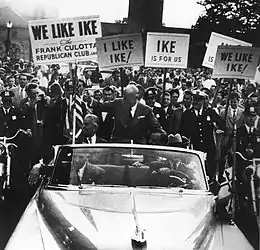
When the 1952 Republican National Convention opened in Chicago, most political experts rated Taft and Eisenhower as neck-and-neck in the delegate vote totals. Eisenhower's managers, led by Governor Dewey and Massachusetts Senator Henry Cabot Lodge, Jr., accused Taft of "stealing" delegate votes in Southern states such as Texas and Georgia. They claimed that Taft's leaders in these states had illegally refused to give delegate spots to Eisenhower supporters and put Taft delegates in their place. Lodge and Dewey proposed to evict the pro-Taft delegates in these states and replace them with pro-Eisenhower delegates; they called this proposal "Fair Play". Although Taft and his supporters angrily denied this charge, the convention voted to support Fair Play 658–548, and Taft lost many Southern delegates; this decided the nomination in Eisenhower's favor. However, the mood at the convention was one of the most bitter and emotional in American history; in one speech Senator Everett Dirksen of Illinois, a Taft supporter, pointed at Governor Dewey on the convention floor and accused him of leading the Republicans "down the road to defeat", and mixed boos and cheers rang out from the delegates. In the end Eisenhower took the nomination on the first ballot; to heal the wounds caused by the battle he went to Taft's hotel suite and met with him. The Convention then chose young Senator Richard Nixon of California as Eisenhower's running mate; it was felt that Nixon's credentials as a slashing campaigner and anti-Communist would be valuable. Most historians now believe that Eisenhower's nomination was primarily due to the feeling that he was a "sure winner" against the Democrats; most of the delegates were conservatives who would probably have supported Taft if they felt he could have won the general election. The balloting at the Republican Convention went: (Richard C. Bain and Judith H. Parris, Convention Decisions and Voting Records, pp. 280–286):
| Presidential Balloting, RNC 1952 | ||
| Contender: Ballot | 1st Before Shifts | 1st After Shifts |
|---|---|---|
| General Dwight D. Eisenhower | 595 | 845 |
| Ohio Senator Robert A. Taft | 500 | 280 |
| Governor Earl Warren of California | 81 | 77 |
| Former Minnesota Governor Harold Stassen | 20 | 0 |
| General Douglas MacArthur | 10 | 4 |
Freshman California Senator Richard Nixon was nominated for Vice President, also with notable Dewey's support. Republican politicians thought that his political experience, aggressive style (he was known as strongly anti-communist) and political base on the West would help political newcomer Eisenhower.[19]
References
- Our Campaigns - Candidate - Thomas Edmund Dewey
- Conklin, William (18 Mar 1952). "DRISCOLL ENTERS EISENHOWER CAMP; JERSEY SWING SEEN: Governor Leads Most of the State's Organized G. O. P. Into Fight for General COUNTY CHIEFS HAIL MOVE Head of Party Feels Results of 'Popularity Race' April 15 Should Have Moral Hold DRISCOLL ENTERS EISENHOWER CAMP". The New York Times. p. 1.
- Gallup, George (17 July 1949). "General Ike, Stassen Hold GOP Voters". The Washington Post. p. B5.
- Gallup, George (6 Nov 1949). "EISENHOWER LEADS IN GOP POPULARITY: Republicans and Independents in Poll Place Harold Stassen Second for 1952 Nomination". Los Angeles Times. p. 16.
- Gallup, George (5 Apr 1950). "GOP Voters Give Eisenhower First Choice for Presidency". The Washington Post. p. 15.
- Gallup, George (27 Sep 1950). "Eisenhower Popularity Booms Among GOP Voters in Survey". The Washington Post. p. 14.
- Gallup, George (17 Dec 1950). "Sen. Taft Found Choice Now Of 24% of Republican Voters: GOP Shift To Taft Noted". The Washington Post. p. M1.
- Gallup, George (13 Apr 1951). "Gen. Eisenhower Voted First Choice Of GOP for Presidency in 1952". The Washington Post. p. 18.
- Gallup, George (23 Dec 1951). "Taft's Popularity Rising, Gallup Finds: Senator Still Trails Eisenhower in Poll of GOP and Independents". Los Angeles Times. p. 4.
- Gallup, George (13 Feb 1952). "Taft, Eisenhower Tied for GOP Vote". The Washington Post. p. 1.
- Gallup, George (2 Mar 1952). "GOP Poll Puts Taft Over Eisenhower: But General Holds Lead With Independents, Gallup Discovers". Los Angeles Times. p. 15.
- Gallup, George (9 Apr 1952). "GOP Race is Tossup, Gallup Poll Discloses: Eisenhower Running Slightly Ahead of Taft; Interviewers Find Gov. Warren Is Gaining". Los Angeles Times. p. B12.
- Gallup, George (2 May 1952). "GOP, Independent Voters Favor Eisenhower Over Taft". The Washington Post. p. 1.
- Gallup, George (4 June 1952). "EISENHOWER LEAD REDUCED IN POLL: Taft Registers Gains Since Last Month in Gallup Republican, Independent Count". Los Angeles Times. p. C5.
- Gallup, George (22 June 1952). "Ike Gains New Popularity As Campaign Hits Stride". The Atlanta Journal. p. 1F.
- Gallup, George (2 July 1952). "TAFT, EISENHOWER CLOSE IN SURVEY: Gallup Finds Party Chairmen Favor Senator While Republican Voters Lean to General". Los Angeles Times. p. 11.
- Primaries, caucuses and conventions: Classic races for the presidential nomination
- Our Campaigns - US President - R Primaries Race - Feb 01, 1952
- Longin Pastusiak, Prezydenci, volume 3
Further reading
- Pickett, William B. (2000). Eisenhower Decides to Run: Presidential Politics and Cold War Strategy. Chicago: Ivan R. Dee. ISBN 1-56-663787-2. OCLC 43953970.

